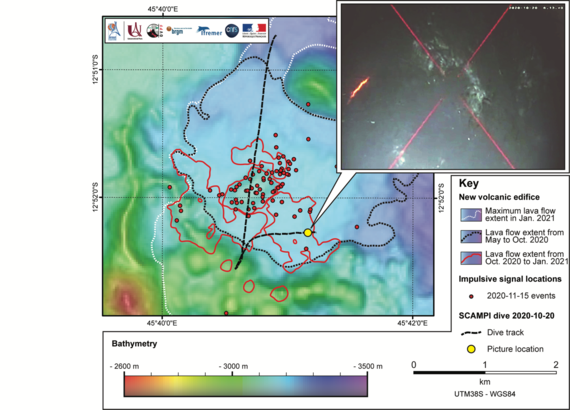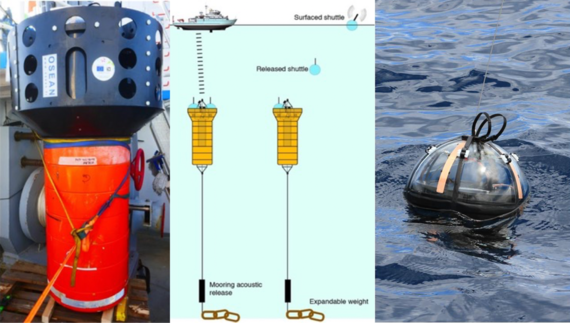MAHY : Studying active volcanic processes using hydrophones off Mayotte
Hydroacoustic monitoring is the acquisition of continuous time series of acoustic signals in the ocean using hydrophone arrays. This observation is particularly well suited to the study of submarine volcanoes as it records seismicity and the sounds associated with eruptions. It also allows the characterisation and monitoring of ambient ocean noise, particularly that generated by large marine mammals. In general, hydroacoustic monitoring is done with very large networks (>1000 km) of moorings. Here we have chosen a distance of 50 km from the volcano to limit the transit time of the ship. The MAHY hydroacoustic array was deployed in the SOFAR channel (1300m depth) in October 2020 (4 hydrophones deployed during MAYOBS15), in April 2021 (4 hydrophones redeployed during MAYOBS18), in September 2021 (only 3 hydrophones redeployed during MAYOBS21), and in July 2022 (4 hydrophones redeployed during MAYOBS23).
Several sources of hydroacoustic waves have been identified: earthquakes, underwater landslides, marine mammal calls of four species and anthropogenic noise (seismic shots and ship engines). Among these sounds, impulsive signals have caught our attention. We associate them with steam formations linked to the outpouring of volcanic flows. Their analysis reveals that the strong eruptive activity observed in the Tiktak flow, 10 km NW of the new volcano at the beginning of the hydroacoustic monitoring, strongly decreased during the first year of recording (Figure **, Bazin et al., 2022), until it stopped on 04/12/2020. We are currently developing automatic detection methods using template matching (Lavayssière et al., 2023) and machine learning (Raumer et al., 2023).
The hydrophones were initially designed with an autonomy of 2 years but due to the difficulty of transporting lithium batteries to and from Reunion Island, we modified the acquisition cards to adapt them to Alkaline batteries. These batteries are less energetic, but easier to transport and less expensive. Our experience shows that their autonomy is now less than 12 months. A later recovery may stop the acquisition but the data are still usable. It should be noted that the recovery of the mooring by acoustic release remains feasible for 3 years.
In addition, we plan to replace conventional moorings with HYDROBS stations (developed by OSEAN) equipped with messengers into which the data are copied and which can be easily recovered by smaller vessels (Figure **). These new instruments are better suited to monitoring missions as they allow data to be retrieved on demand.


